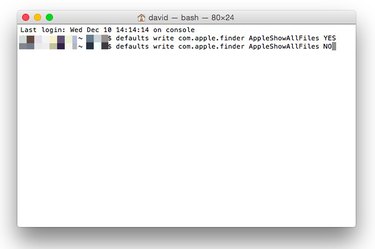

- #Mac os x show hidden files 2017 how to
- #Mac os x show hidden files 2017 software
- #Mac os x show hidden files 2017 password
All software built for the Mac after June 1 of this year must be uploaded to Apple’s servers, scanned by an automated system, and approved. Unfortunately, sometimes these changes can get in the way of you being able to run the software that you want to run. In Catalina, Apple has locked down more of the system to protect users from potential malware. I use this all the time to transfer big audio files to my iPad for editing, and to transfer the final audio projects back to my Mac when I’m done. If you’ve ever needed to transfer large files between your Mac and iOS devices, and have balked at using the cloud or AirDrop to do so, you can also do so across a wired connection, right within the Finder. This isn’t anything new, but the Finder is a much more sensible place for it.
#Mac os x show hidden files 2017 password
Once you’ve connected an iOS device to your Mac and entered your password to allow the Mac to be a trusted device, you can click on the Files tab and get a look inside the storage on your device. Copy files to iOS devices in FinderĪpple has moved iOS device management out of iTunes (which is now gone!) and into the Finder. All those features have been on iOS for a while now, but they’re finally on the Mac too. If you are interested, let us know and related guide will be coming soon.In the new Find My app, you can locate your device, and even mark it as lost, or remotely erase it.Īnd of course, you can now find your devices-and your friends-right from your Mac via the new Find My app, which lets you mark devices as lost, see their last known locations, and also alert you when a friend leaves or arrives at particular locations. Besides, you can encrypt your entire hard drive using the built-in FileVault so that others cannot access to your contents unless knowing your password. The key is to remember the name of the hidden file or folder.Īdvanced users can utilize Automator to create a workflow to hide and show items more conveniently. You just need to repeat the same steps above, and use the same command with the nohidden flag ( chflags nohidden ) to show the hidden item.
If the filename contains spaces, you’d better put quotes around it like: chflags hidden “~/Documents/Hide This Folder”.Īfter hiding the file or folder, you might need to view it occasionally. The correct format of hidden command is: chflags hidden.

You can type the name of the file/folder behind the chflags hidden command instead of dragging the item to the command window. Yet they are not deleted and still in the original location. If you hide a folder by this way, the folder and all its contents will disappear as well. The select item will disappear from view in the Finder. Hit the Enter key to execute the hidden command. As soon as you drop the items into the Terminal window, the file/folder path will appear behind the command. Now you can locate the file or folder you want to hide, and drag its icon to the command window. Make sure to press the space key twice before and after typing the command. Then you can type the following command: chflags hidden. There are multiple ways to access Terminal app on Mac and you can choose one of them:ġ.Launch Finder and open up Terminal in the /Applications/Utilities folder.Ģ.Press Command + Space keys simultaneously, type Terminal and hit Enter key.ģ.In Finder, head to the Go menu, choose Utilities and then Terminal.Īs the Terminal launches, a new command window will appear. Terminal is the built-in app that can help hide files and folders with easy steps.
#Mac os x show hidden files 2017 how to
This tutorial will show you how to hide any file or folders on macOS Sierra and how to view the hidden ones.

The alternative way of hiding an item is to use the chflags command in Terminal. Then how to hide files or folders on macOS Sierra? And how to show those hidden items when you need to? Finder does not offer a built-in option to hide an item. In some circumstances you would like to make some private files out of view, so as to stop prying eyes or avoid mistakenly deletion.


 0 kommentar(er)
0 kommentar(er)
